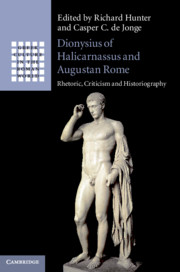Book contents
- Dionysius of Halicarnassus and Augustan Rome
- Greek Culture in the Roman World
- Dionysius of Halicarnassus and Augustan Rome
- Copyright page
- Contents
- Contributors
- Acknowledgements
- A note on editions, translations and abbreviations
- Introduction
- Part 1 Dionysius and Augustan Rhetoric and Literary Criticism
- Part 2 Dionysius and Augustan Historiography
- Part 3 Dionysius and Augustan Rome
- Envoi: Migrancy
- Bibliography
- Index of Passages Discussed
- General Index
- References
Bibliography
Published online by Cambridge University Press: 12 October 2018
- Dionysius of Halicarnassus and Augustan Rome
- Greek Culture in the Roman World
- Dionysius of Halicarnassus and Augustan Rome
- Copyright page
- Contents
- Contributors
- Acknowledgements
- A note on editions, translations and abbreviations
- Introduction
- Part 1 Dionysius and Augustan Rhetoric and Literary Criticism
- Part 2 Dionysius and Augustan Historiography
- Part 3 Dionysius and Augustan Rome
- Envoi: Migrancy
- Bibliography
- Index of Passages Discussed
- General Index
- References
Summary

- Type
- Chapter
- Information
- Dionysius of Halicarnassus and Augustan RomeRhetoric, Criticism and Historiography, pp. 278 - 296Publisher: Cambridge University PressPrint publication year: 2018

